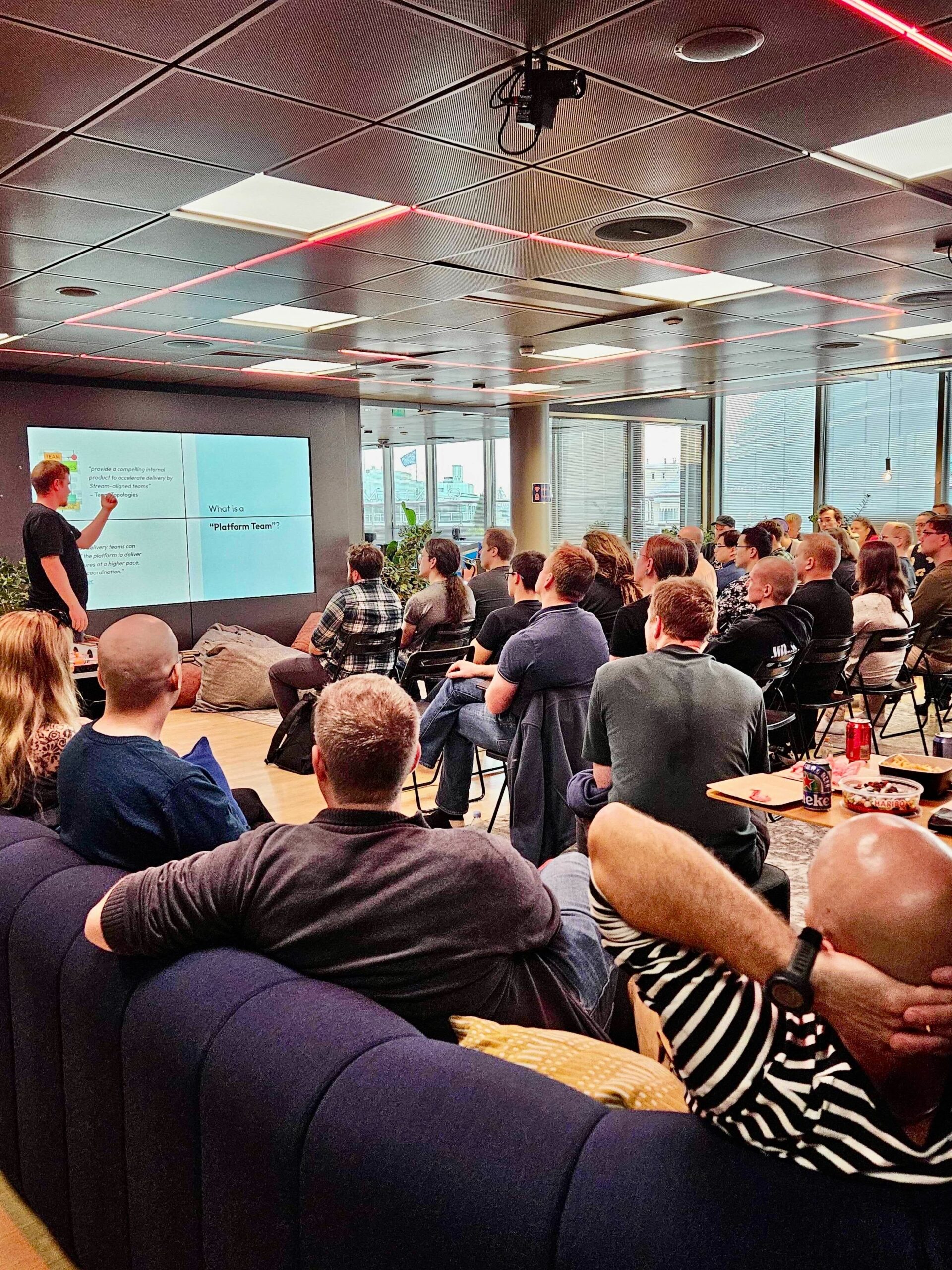The power of Java ecosystem lies in the Java Virtual Machine (JVM) which runs variety of programming languages which are better suitable for some tasks than Java. One relatively new JVM language is Kotlin which is statically typed programming language that targets the JVM and JavaScript. You can use it with Java, Android and the browser and it’s 100% interoperable with Java. Kotlin is open source (Apache 2 License) and developed by a team at JetBrains. The name comes from the Kotlin Island, near St. Petersburg. The first officially considered stable release of Kotlin v1.0 was released on February 15, 2016.
Why Kotlin?
“Kotlin is designed to be an industrial-strength object-oriented language, and to be a better language than Java but still be fully interoperable with Java code, allowing companies to make a gradual migration from Java to Kotlin.” – Kotlin, Wikipedia
Kotlin’s page summaries the question “Why Kotlin?” to:
- Concise: Reduce the amount of boilerplate code you need to write.
- Safe: Avoid entire classes of errors such as null pointer exceptions.
- Versatile: Build server-side applications, Android apps or frontend code running in the browser. You can write code in Kotlin and target JavaScript to run on Node.js or in browser.
- Interoperable: Leverage existing frameworks and libraries of the JVM with 100% Java Interoperability.
“You can write code that’s more expressive and more concise than even a scripting language, but with way fewer bugs and with way better performance.” – Why Kotlin is my next programming language
One of the obvious applications of Kotlin is Android development as the platform uses Java 6 although it can use most of Java 7 and some backported Java 8 features. Only the recent Android N which changes to use OpenJDK introduces support for Java 8 language features.
For Java developers one significant feature in Kotlin is Higher-Order Functions, function that takes functions as parameters, which makes functional programming more convenient than in Java. But in general, I’m not so sure if using Kotlin compared to Java 8 is as much beneficial. It smooths off a lot of Java’s rough edges, makes code leaner and costs nothing to adopt (other than using IntelliJ IDEA) so it’s at least worth trying. But if you’re stuck with legacy code and can’t upgrade from Java 6, I would jump right in.
Learning Kotlin
Coming from Java background Kotlin at first glance looks a lot leaner, elegant, simpler and the syntax is familiar if you’ve written Swift. To get to know the language it’s useful to do some Kotlin Examples and Koans which get you through how it works. They also have “Convert from Java” tool which is useful to see how Java classes translate to Kotlin. For mode detailed information you can read the complete reference to the Kotlin language and the standard library.
If you compare Kotlin to Java you see that null references are controlled by the type system, there’s no raw types, arrays are invariant (can’t assign an Array to an Array) and there’s no checked exceptions. Also semicolons are not required, there’s no static members, non-private fields or wildcard types.
And what Kotlin has that Java doesn’t have? For starters there’s null safety, smart casts, extension functions and lots of things Java just got in recent versions like Null safety, streams, lambdas ( although which are “expensive”). On the other hand Kotlin targets Java 6 bytecode and doesn’t use some of the improvements in Java 8 like invoke-dynamic or lambda support. Some of JDK7/8 features are going to be included in Standard Library in 1.1 and in the mean time you can use small kotlinx-support library. It provides extension and top-level functions to use JDK7/JDK8 features such as calling default methods of collection interfaces and use extension for AutoCloseable.
And you can also call Java code from Kotlin which makes it easier to write it alongside Java if you want to utilize it in existing project and write some part of your codebase with Kotlin.
The Kotlin Discuss is also nice forum to read experiences of using Kotlin.
Tooling: in practice IntelliJ IDEA
You can use simple text editors and compile your code from the command line or use build tools such as Ant, Gradle and Maven but good IDEs make the development more convenient. In practice, using Kotlin is easiest with JetBrains IntelliJ IDEA and you can use their open source Community edition for free. There’s also Eclipse plugin for Kotlin but naturally it’s much less sophisticated than the IntelliJ support.
Example project
The simplest way to start with Kotlin application is to use Spring Boot’s project generator, add your dependencies, choose Gradle or Maven and click on “Generate Project”.
There are some gotchas with using Spring and Kotling together which can be seen from Spring + Kotlin FAQ. For example by default, classes are final and you have to mark them as “open” if you want the standard Java behaviour. This is useful to know with @Configuration classes and @Bean methods. There’s also Kotlin Primavera which is a set of libraries to support Spring portfolio projects.
For example Spring Boot + Kotlin application you should look at Spring.io writeup where they do a geospatial messenger with Kotlin, Spring Boot and PostgreSQL
What does Kotlin look like compared to Java?
Simple example of using Java 6, Java 8 and Kotlin to filter a Map and return a String. Notice that Kotlin and Java 8 are quite similar.
# Java 6
String result = "";
for (Map.Entry<Integer, String> entry : someMap.entrySet()) {
if("something".equals(entry.getValue())){
result += entry.getValue();
}
# Java 8
String result = someMap.entrySet().stream()
.filter(map -> "something".equals(map.getValue()))
.map(map->map.getValue())
.collect(Collectors.joining());
# Kotlin
val result = someMap
.values
.filter { it == "something" }
.joinToString("")
# Kotlin, shorter
val str = "something"
val result = str.repeat(someMap.count { it.value == str })
# Kotlin, more efficient with large maps where only some matching.
val result = someMap
.asSequence()
.map { it.value }
.filter { it == "something" }
.joinToString("")
The last Kotlin example makes the evaluation lazy by changing the map to sequence. In Kotlin collections map/filter methods aren’t lazy by default but create always a new collection. So if we call filter after values method then it’s not as efficient with large maps where only some elements are matching the predicate.
Using Java and Kotlin in same project
To start with Kotlin it’s easiest to mix it existing Java project and write some classes with Kotlin. Using Kotlin in Maven project is explained in the Reference and to compile mixed code applications Kotlin compiler should be invoked before Java compiler. In maven terms that means kotlin-maven-plugin should be run before maven-compiler-plugin.
Just add the kotlin and kotlin-maven-plugin to your pom.xml as following
<dependencies>
<dependency>
<groupId>org.jetbrains.kotlin</groupId>
<artifactId>kotlin-stdlib</artifactId>
<version>1.0.3</version>
</dependency>
</dependencies>
<plugin>
<artifactId>kotlin-maven-plugin</artifactId>
<groupId>org.jetbrains.kotlin</groupId>
<version>1.0.3</version>
<executions>
<execution>
<id>compile</id>
<phase>process-sources</phase>
<goals> <goal>compile</goal> </goals>
</execution>
<execution>
<id>test-compile</id>
<phase>process-test-sources</phase>
<goals> <goal>test-compile</goal> </goals>
</execution>
</executions>
</plugin>
Notes on testing
Almost everything is final in Kotlin by default (classes, methods, etc) which is good as it forces immutability, less bugs. In most cases you use interfaces which you can easily mock and in integration and functional tests you’re likely to use real classes, so even then final is not an obstacle. For using Mockito there’s Mockito-Kotlin library https://github.com/nhaarman/mockito-kotlin which provides helper functions.
You can also do better than just tests by using Spek which is a specification framework for Kotlin. It allows you to easily define specifications in a clear, understandable, human readable way.
There’s yet no static analyzers for Kotlin. Java has: FindBugs, PMD, Checkstyle, Sonarqube, Error Prone, FB infer. Kotlin has kotlinc and IntelliJ itself comes with static analysis engine called the Inspector. Findbugs works with Kotlin but detects some issues that are already covered by the programming language itself and are impossible in Kotlin.
To use Kotlin or not?
After writing some classes with Kotlin and testing converting existing Java classes to Kotlin it makes the code leaner and easier to read especially with data classes like DTOs. Less (boilerplate) code is better. You can call Java code from Kotlin and Kotlin code can be used from Java rather smoothly as well although there are some things to remember.
So, to use Kotlin or not? It looks a good statically-typed alternative to Java if you want to expand your horizons. It’s pragmatic evolution to Java that respects the need for good Java integration and doesn’t introduce anything that’s terribly hard to understand and includes a whole bunch of features you might like. The downsides what I’ve come across are that tooling support is kind of limited, meaning in practice only IntelliJ IDEA. Also documentation isn’t always up to date or updated when the language evolves and that’s also an issue when searching for examples and issues. But hey, everything is fun with Kotlin :)


